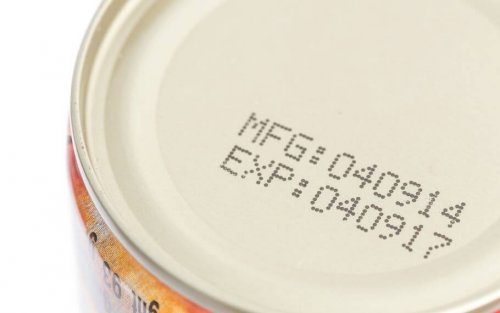Learn How to Differentiate Between the Preferred by and Expiration Dates

Alongside the prices or brands, something that we often look for when grocery shopping is the expiration date. After all, we’re all familiar with the following scenario: a food product in our home that’s been in the cupboard for a while. In this case, we usually check the label for a date to prevent any unpleasant surprises. But, what’s the difference between the preferred by and expiration date?
The shelf-life of a food product
Consumers don’t usually distinguish between the preferred by date and the expiration date because they’re often confused with the same meaning. Consequently, people throw out food on the basis of being past the indicated date on the product label.
The confusion between the two terms stems from the product labels themselves because in most cases, they’re not very clear. They might have a complete date (day, month, year) or a partial date (month and year or just the year). But, these dates don’t necessarily mean that from that moment on, the food product is no longer safe for consumption.

Oftentimes, when we doubt a product, we discard it and buy another one. These doubts can have negative impacts on our wallet as well as on the environment. But of course, the companies that make the products will always encourage more sales.
These aren’t the only problems. The lack of planning or managing our food supply generates millions of tons of food waste each year. There are many products that end up being wasted when they could still be consumed.
Efficiently organizing our food products at home is essential and choosing to store them correctly is also crucial. We suggest organizing your items by size; that way, everything will stay in sight, in a fresh, dry place with proper ventilation.
In your pantry, try placing the products with a longer expiration date further toward the back, while keeping the ones with a shorter date near to the front.
So, what’s the difference between the preferred by date and the expiration date?
Regardless of how well we organize our kitchen, pantry or fridge, we need to understand the differences between the dates that we find on our food product labels:
1. Expiration date
The expiration date refers to the date from which a product should no longer be consumed. Now, that’s not to say that just a day or two after the printed date, the product will be completely spoiled! However, it does mean that with each passing day, there’s a bigger risk of food poisoning.
On some food products, such as pasteurized products (milk, cream, yogurt), meat or vacuum-sealed foods, you’ll always find an expiration date. It clearly indicates the date that the food product needs to be consumed by, so as to avoid the risk of any digestive problems.

Preferred by date
In the case of the preferred by date, the date refers to a recommended time to consume the product (the label will probably just display a month and date, or even just a year). After the indicated time, the quality of the food product deteriorates, but won’t necessarily present any health problems if it’s consumed.
The preferred by date is usually found on dried food products, or those with a low water content (grains, legumes, oils), sterilized products (milk bottles, canned foods) and eggs. So, basically, the food product will start to lose its taste, texture and properties starting from the preferred by date.
Besides knowing how to differentiate between the expiration and preferred by dates, another important factor is to be aware of the dates, while the product is still sealed. If you’ve already opened a product, the display date might be irrelevant, because the product won’t stay as fresh for as long.
However, manufacturers do try to consider the dates of opened products too. They often base dates on the time period that consumers might leave them open for, in the fridge or pantry.
Alongside the prices or brands, something that we often look for when grocery shopping is the expiration date. After all, we’re all familiar with the following scenario: a food product in our home that’s been in the cupboard for a while. In this case, we usually check the label for a date to prevent any unpleasant surprises. But, what’s the difference between the preferred by and expiration date?
The shelf-life of a food product
Consumers don’t usually distinguish between the preferred by date and the expiration date because they’re often confused with the same meaning. Consequently, people throw out food on the basis of being past the indicated date on the product label.
The confusion between the two terms stems from the product labels themselves because in most cases, they’re not very clear. They might have a complete date (day, month, year) or a partial date (month and year or just the year). But, these dates don’t necessarily mean that from that moment on, the food product is no longer safe for consumption.

Oftentimes, when we doubt a product, we discard it and buy another one. These doubts can have negative impacts on our wallet as well as on the environment. But of course, the companies that make the products will always encourage more sales.
These aren’t the only problems. The lack of planning or managing our food supply generates millions of tons of food waste each year. There are many products that end up being wasted when they could still be consumed.
Efficiently organizing our food products at home is essential and choosing to store them correctly is also crucial. We suggest organizing your items by size; that way, everything will stay in sight, in a fresh, dry place with proper ventilation.
In your pantry, try placing the products with a longer expiration date further toward the back, while keeping the ones with a shorter date near to the front.
So, what’s the difference between the preferred by date and the expiration date?
Regardless of how well we organize our kitchen, pantry or fridge, we need to understand the differences between the dates that we find on our food product labels:
1. Expiration date
The expiration date refers to the date from which a product should no longer be consumed. Now, that’s not to say that just a day or two after the printed date, the product will be completely spoiled! However, it does mean that with each passing day, there’s a bigger risk of food poisoning.
On some food products, such as pasteurized products (milk, cream, yogurt), meat or vacuum-sealed foods, you’ll always find an expiration date. It clearly indicates the date that the food product needs to be consumed by, so as to avoid the risk of any digestive problems.

Preferred by date
In the case of the preferred by date, the date refers to a recommended time to consume the product (the label will probably just display a month and date, or even just a year). After the indicated time, the quality of the food product deteriorates, but won’t necessarily present any health problems if it’s consumed.
The preferred by date is usually found on dried food products, or those with a low water content (grains, legumes, oils), sterilized products (milk bottles, canned foods) and eggs. So, basically, the food product will start to lose its taste, texture and properties starting from the preferred by date.
Besides knowing how to differentiate between the expiration and preferred by dates, another important factor is to be aware of the dates, while the product is still sealed. If you’ve already opened a product, the display date might be irrelevant, because the product won’t stay as fresh for as long.
However, manufacturers do try to consider the dates of opened products too. They often base dates on the time period that consumers might leave them open for, in the fridge or pantry.
This text is provided for informational purposes only and does not replace consultation with a professional. If in doubt, consult your specialist.








